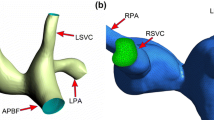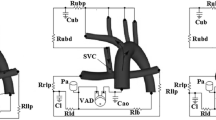Abstract
Computational fluid dynamics (CFD) have been used to investigate the hemodynamic performance in cavopulmonary anastomosis and resulted in improved operative design. In this study, CFD simulations were performed in a patient-specific bilateral bidirectional Glenn (BBDG) connection model and the power losses as well as flow features at different levels of predetermined pulmonary flow splits were calculated and compared. The control volume power loss varied between 0.64 and 1.02 mW when the flow ratio of left pulmonary artery/right pulmonary artery changed from 80:20 to 20:80. The flow patterns within the connection area and the static pressures in the four vessels differed from each other as the pulmonary flow split changed. Power loss and flow patterns of this BBDG connection were influenced by the pulmonary flow split.






Similar content being viewed by others
References
Amodeo A, Di Donato RM (2007) The unifocal bilateral bidirectional cavopulmonary anastomosis. Ann Thorac Surg 84:2134–2135. doi:10.1016/j.athoracsur.2007.04.071
Bove EL, de Leval MR, Migliavacca F, Guadagni G, Dubini G (2003) Computational fluid dynamics in the evaluation of hemodynamic performance of cavopulmonary connections after the Norwood procedure for hypoplastic left heart syndrome. J Thorac Cardiovasc Surg 126:1040–1047. doi:10.1016/S0022-5223(03)00698-6
Bridges ND, Jonas RA, Mayer JE, Flanagan MF, Keane JF, Castaneda AR (1990) Bidirectional cavopulmonary anastomosis as interim palliation for high-risk Fontan candidates. Early results. Circulation 82(5(Suppl)):IV170–IV176
Campbell M, Deuchar DC (1954) The left-sided superior vena cava. Br Heart J 16:423–439. doi:10.1136/hrt.16.4.423
Cilliers A, Gewillig M (2002) Fontan procedure for univentricular hearts: Have changes in design improved outcome? Cardiovasc J S Afr 13:111–116
de Leval MR, Ritter DG, McGoon DC, Danielson GK (1975) Anomalous systemic venous connection. Surgical considerations. Mayo Clin Proc 50:599–610
de Leval MR, Kilner P, Gewillig M, Bull C (1988) Total cavopulmonary connection: a logical alternative to atriopulmonary connection for complex Fontan operations. J Thorac Cardiovasc Surg 96:682–695
de Zélicourt DA, Pekkan K, Paks J, Kanter K, Fogel M, Yoganathan AP (2006) Flow study of an extracardiac connection with persistent left superior vena cava. J Thorac Cardiovasc Surg 131:785–791. doi:10.1016/j.jtcvs.2005.11.031
Hess J (2001) Long-term problems after cavopulmonary anastomosis: diagnosis and management. Thorac Cardiovasc Surg 49:98–100. doi:10.1055/s-2001-11698
Jacobs ML, Pourmoghadam KK (2003) The hemi-Fontan operation. Semin Thorac Cardiovasc Surg Pediatr Card Surg Annu 6:90–97. doi:10.1053/pcsu.2003.50007
Khunatorn Y, Mahalingam S, DeGroff CG, Shandas R (2002) Influence of connection geometry and SVC-IVC flow rate ratio on flow structures within the total cavopulmonary connection: a numerical study. J Biomech Eng 124:364–377. doi:10.1115/1.1487880
Liu Y, Pekkan K, Jones SC, Yoganathan AP (2004) The effects of different mesh generation methods on fluid dynamic analysis and power loss in total cavopulmonary connection. J Biomech Eng 126:594–603. doi:10.1115/1.1800553
Marino BS (2002) Outcomes after the Fontan procedure. Curr Opin Pediatr 14:620–626. doi:10.1097/00008480-200210000-00010
Marsden AL, Vignon-Clementel IE, Chan FP, Feinstein JA, Taylor CA (2007) Effects of exercise and respiration on hemodynamic efficiency in CFD simulations of the total cavopulmonary connection. Ann Biomed Eng 35:250–263. doi:10.1007/s10439-006-9224-3
Mastalir ET, Kalil RA, Horowitz ES, Wender O, Sant’Anna JR, Prates PR et al (2002) Late clinical outcomes of the Fontan operation in patients with tricuspid atresia. Arq Bras Cardiol 79:56–60. doi:10.1590/S0066-782X2002001000006
Mendelsohn AM, Bove EL, Lupinetti FM, Crowley DC, Lloyd TR, Beekman RHIII (1994) Central pulmonary artery growth patterns after the bidirectional Glenn procedure. J Thorac Cardiovasc Surg 107:1284–1290
Migliavacca F, de Leval MR, Dubini G, Pietrabissa R, Fumero R (1999) Computational fluid dynamic simulations of cavopulmonary connections with an extracardiac lateral conduit. Med Eng Phys 21:187–193. doi:10.1016/S1350-4533(99)00042-9
Migliavacca F, Dubini G, Bove EL, de Leval MR (2003) Computational fluid dynamics simulations in realistic 3-D geometries of the total cavopulmonary anastomosis: the influence of the inferior caval anastomosis. J Biomech Eng 125:805–813. doi:10.1115/1.1632523
Pekkan K, de Zélicourt D, Ge L, Sotiropoulos F, Frakes D, Fogel MA et al (2005) Physics-driven CFD modeling of complex anatomical cardiovascular flows-a TCPC case study. Ann Biomed Eng 33:284–300. doi:10.1007/s10439-005-1731-0
Pittaccio S, Migliavacca F, Dubini G, Koçyildirim E, de Leval MR (2005) On the use of computational models for the quantitative assessment of surgery in congenital heart disease. Anadolu Kardiyol Derg 5:202–209
van den Bosch AE, Roos-Hesselink JW, Van Domburg R, Bogers AJ, Simoons ML, Meijboom FJ (2004) Long-term outcome and quality of life in adult patients after the Fontan operation. Am J Cardiol 93:1141–1145. doi:10.1016/j.amjcard.2004.01.041
Wang C, Pekkan K, de Zélicourt D, Horner M, Parihar A, Kulkarni A et al (2007) Progress in the CFD modeling of flow instabilities in anatomical total cavopulmonary connections. Ann Biomed Eng 35:1840–1856. doi:10.1007/s10439-007-9356-0
Whitehead KK, Pekkan K, Kitajima HD, Paridon SM, Yoganathan AP, Fogel MA (2007) Nonlinear power loss during exercise in single-ventricle patients after the Fontan: insights from computational fluid dynamics. Circulation 116(11(Suppl)):I165–I171. doi:10.1161/CIRCULATIONAHA.106.680827
Acknowledgments
This work was supported by the National Nature Science Foundation of China under grant number 30672087 and the Science and Technology Committee of Shanghai Municipality under grant number 064307056.
Author information
Authors and Affiliations
Corresponding author
Rights and permissions
About this article
Cite this article
Sun, Q., Wan, D., Liu, J. et al. Patient-specific computational fluid dynamic simulation of a bilateral bidirectional Glenn connection. Med Biol Eng Comput 46, 1153–1159 (2008). https://doi.org/10.1007/s11517-008-0376-1
Received:
Accepted:
Published:
Issue Date:
DOI: https://doi.org/10.1007/s11517-008-0376-1




